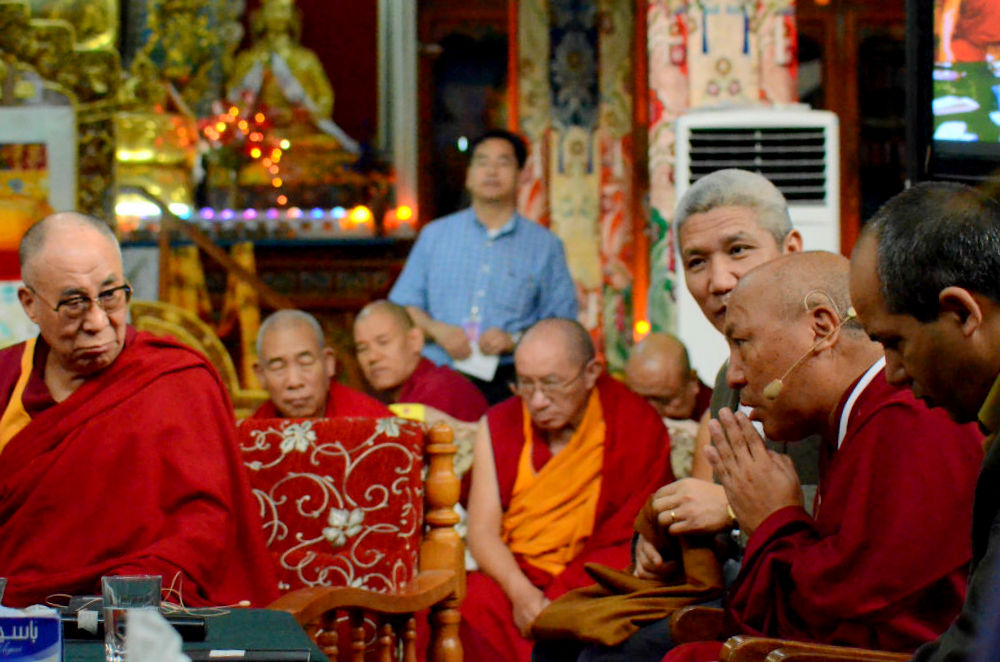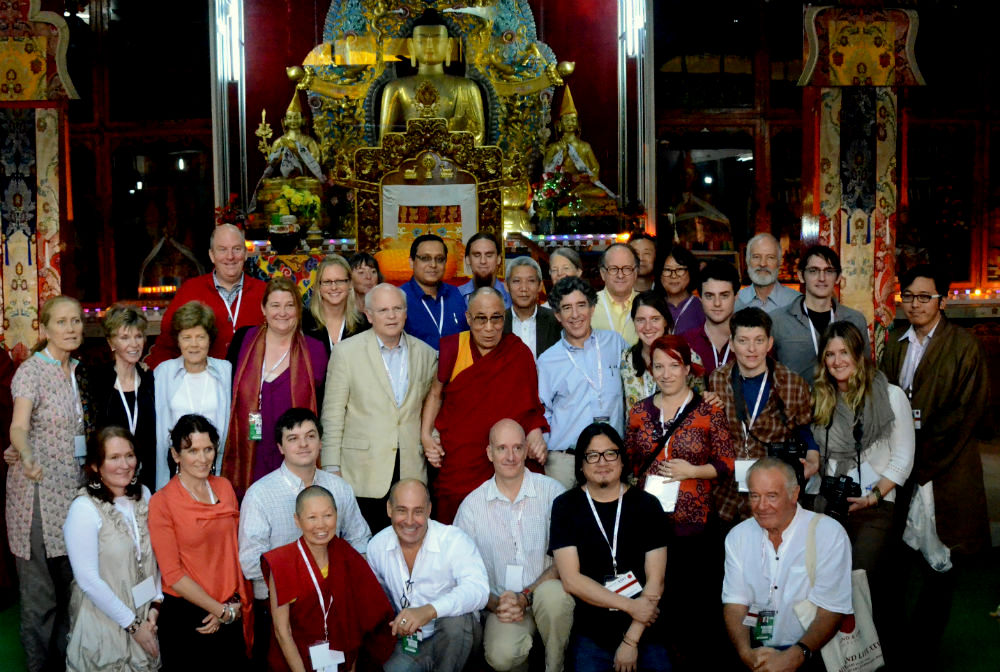Mundgod, Karnataka, India: - The 26th Mind & Life conference successfully concluded on January 22, at the Drepung Monastery, known as the second Nalanda University of Tibet. Over 8000 people, the majority of them Tibetan monastics attended the 6-day event, which also attracted significant interest worldwide. The live webcast of the event on www.dalailama.com received 240,000 hits over the course of the event.

Diana Chapman Walsh welcomed His Holiness The Dalai Lama and all those who were present. She said,"The nature of this conference has been something quite special. This is the 26th occasion that we have met with scientists and scholars, but this time the location is different. Here at Drepung, rigorous study has gone on for hundreds of years, and it happens to be the monastery closely associated with the line of Dalai Lamas. Many have participated with great enthusiasm, and everyone has been pleased with how they too have gone. The conference has been meaningful."
His Holiness spoke on the origins of this mutual exploration between modern science and Buddhist science and philosophy. He said that even as a child he was curious to know how things worked and would dismantle his clocks and toys. After beginning to study Buddhist epistemology and logic his curiosity about why things happen the way they do was sharpened. He gradually became more interested in science. While proud of Tibetan Buddhism's analytical methods, he recognised that modern science pursued the truth in different but complementary ways. This was a recognition he felt he should not keep to himself but share with others.
There were those concerned that science would be a distraction, but in 1999 Amchok Rinpoche requested His Holiness to give firm advice to the monastic community of the efficacy of studying science. He did, but also pointed out that they had understanding and experience of consciousness to share in return. Programmes teaching mindfulness under the auspices of the Mind & Life Institute in North America and Europe have been successful because people have found them to be practical and beneficial. Plans are afoot for MLI meetings in Japan and elsewhere.

Speaking to Tibetan schoolchildren, he said that in the twenty-first century it is possible to study Buddhism as laypersons and he urged them to do so. The Tibetan tradition of logic and Middle Way (Madhyamaka) philosophy is something of great value. Similarly, the tradition of wishing for the well-being of all sentient beings and the tendency to protect life is precious. "Tibetans, especially those in Tibet, are presently in a very sad situation, and yet people from elsewhere still remark that we are on the whole kind, honest and warm-hearted. This and our language and Buddhist heritage are things to be proud of. At the same time, these days I talk a lot about secular ethics, common sense supported by science, and its value to the world. Our goal is to serve others according to their needs and dispositions."
He added, "When I met with the Mind & Life Institute last year I encouraged you to come to the monasteries in South India, where, because it's hot, it's a little inconvenient, but it has gone very well. I'm looking forward to our future meetings in Dharamsala and in other parts of the world."
Geshe Lhakdor, the co-host, spoke about the project of introducing science into Tibetan Buddhist monasteries. Lhakdor said that irrespective of the form initiatives take, it is essential that the ideas do not simply remain on paper, but are actually put into practice. There are many Buddhists who do not really know what the practice of Buddhism entails, and as far as the public is concerned many do not understand scientific theory, but remain contented with its results. This dialogue is an attempt to improve understanding of both traditions. . Lhakdor said, "The dialogue between science and Buddhism is aimed at promoting human happiness and relieving suffering. The word science means knowledge and as we know it is a lack of knowledge that is a cause of suffering. Therefore, it is necessary for us to generate insight into the world to alleviate suffering, and in that science and Buddhism have a common goal."
Ten years ago the Library of Tibetan Works & Archives (LTWA) was asked to form a science programme. Amchok Rinpoche lay its foundations and Geshe Lhakdor in 2005 expanded it. Because of the need for scientific literature in Tibetan, they began to prepare texts. A group of six Tibetans has been training to do this at Emory University in Atlanta, Georgia, USA and a second group is already in training. Annual summer programmes have been organized for students from 24 monasteries and nunneries from all traditions of Tibetan Buddhism.
It is common in Tibetan Buddhist culture to express concern for all mother sentient beings, but we need to put this concern into effect. In western scientific culture there is a trend to organize public programmes to raise public awareness of crucial issues. An example is health care. Geshe Lhakdor lamented how often monks work hard to complete their studies and qualify as teachers only to succumb to poor health. We need simple steps to curtail this loss, he said. "His Holiness has often remarked that Tibetans visit monasteries and temples admiring the buildings and images without appreciating the treasury of knowledge they represent." Last year a resolution was passed to introduce science into the monastic curriculum. This will begin with the Three Great Seats of Learning, Drepung, Sera and Ganden, but will be by no means restricted to Gelugpa monks and nuns, including those from other traditions who wish to join too.

Geshe Lobsang Tenzin Negi spoke on behalf of the Emory Tibet Science Initiative (ETSI). He recalled His Holiness telling the monastic community here at Drepung, in 1986, of the need to study science and the encouragement he was giving scientists to study Buddhist science and philosophy. "In 1987, you helped launch the Mind & Life (MLI) dialogues, which was further evidence of your far-sighted vision. Then to ensure the introduction of science into the monasteries and nunneries, you commissioned Emory University to work with the LTWA to put it into effect." He said this has resulted in three phases – 2006 to 2007 planning, undertaken by a number of experienced Tibetan and Western scholars under His Holiness's guidance, during which it was decided to offer 6 year bilingual courses in physics, neuroscience and biology. This was followed by a development Phase 2008-13, during which the courses were created. From 2014-23, one will see the implementation phase. Geshe Lobsang Tenzin Negi said that as the development phase comes to a close those involved feel ready and eager to launch the ETSI programme. While the Three Great Seats of Learning have been in existence for six centuries, it is going to be a challenge to introduce changes without disturbing the prevailing pattern of study.
The first four years of science will be taught to coincide with the Higher Knowledge (Abhidharma) courses, while the remaining two years will coincide with the Karam classes. However, as the courses are modelled on the monastic debate style, they will ultimately depend on Tibetan teachers. Geshe Lobsang Tenzin Negi concluded.
Arthur Zajonc, President of the Mind & Life Institute gave the vote of thanks.